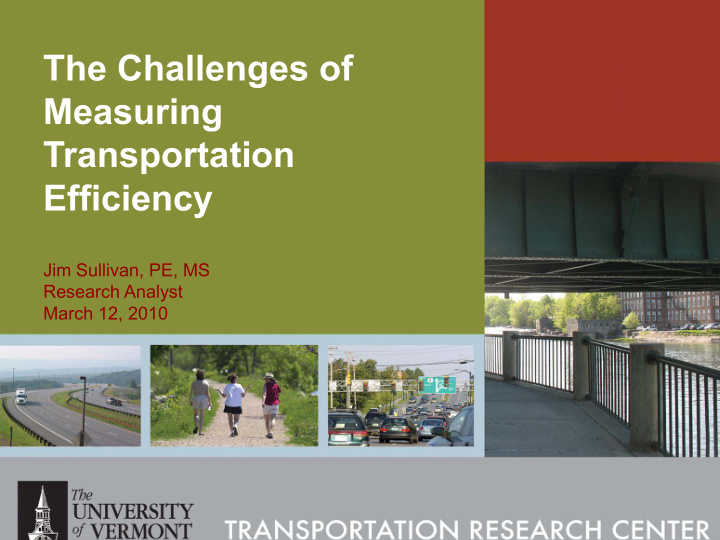



The Challenges of Measuring Transportation Efficiency Jim Sullivan, PE, MS Research Analyst March 12, 2010
The Challenges of Measuring Transportation Efficiency • Motivation • Literature Review • Definition of Transportation Efficiency (TE) • The Challenges of Measuring TE • Hopeful Examples • Conclusions
Motivation • Oil dependence and fuel prices – “Peak oil” and Summer 2008 gasoline prices – 95% of global transportation energy is oil • Emissions and global warming – 28% of GHG emissions in the US in 2006 • Rural and non-traditional region applications Motivation Literature Review Definition Challenges Hopeful Examples Conclusions
Literature Review • Ambiguity in the use of term “transportation efficiency” – Transportation-Energy Efficiency Transportation- – Transportation-System Efficiency System Efficiency • Strategies Associated with TE – Capacity-utilization Transportation Energy – Emissions reductions Efficiency – Land-use improvements Motivation Literature Review Definition Challenges Hopeful Examples Conclusions
Literature Review (cont.) • Derived Measures of TE – Utility Models – Macroeconomic Models – Data Envelopment Analyses – Multiple-Criteria Analyses – Least-Cost Planning Motivation Literature Review Definition Challenges Hopeful Examples Conclusions
Definition of Transportation Efficiency • Common Variables/Criteria • Common Themes: – Maximization of Service – Minimization of Cost • Derived models attempt to assimilate a variety of variables to make: – Spatial comparisons – “System” comparisons – Temporal comparisons Motivation Literature Review Definition Challenges Hopeful Examples Conclusions
Definition of Transportation Efficiency Spatial or “System” Comparisons: Temporal Comparisons: Motivation Literature Review Definition Challenges Hopeful Examples Conclusions
The Challenges of Measuring Transportation Efficiency • The “Rebound” Effect – Energy demand – Transportation demand (generated traffic, or induced demand) – A temporal boundary problem • The “Shifting” Effect – A spatial or “system” boundary problem Motivation Literature Review Definition Challenges Hopeful Examples Conclusions
Hopeful Examples • Least-Cost Planning – Useful parallels between electricity and transportation: • Critical public infrastructure • Efficiency is important • Efficiency viewed as a provider of supply – Complications related to LCP in transportation: • No single service variable, like kW • No central control of service, more stakeholders • Multiple-Criteria Analysis – Limitless inclusiveness – Provides the opportunity to weight criteria – Flexible boundaries Motivation Literature Review Definition Challenges Hopeful Examples Conclusions
Conclusions • Importance of dealing with “rebound” effects and “shifting” effects • Importance of using an assimilative model, like LCP or MCA Motivation Literature Review Definition Challenges Hopeful Examples Conclusions
Thank You
Questions?
Recommend
More recommend